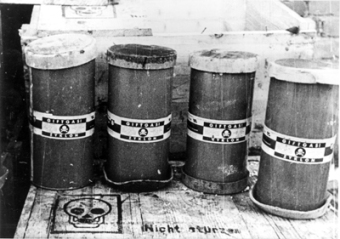Zyklon B: An Insecticide Becomes a Means for Mass Murder

© National Archives, Washington, DC
Under the name Zyklon B, the German Corporation for Pest Control (Deutsche Gesellschaft für Schädlingsbekämpfung mbH; Degesch), doing business today as Detia Degesch GmbH, marketed an insecticide based on hydrogen cyanide (HCN), which was applied to a porous carrier (diotomaceous earth) and packed in airtight metal containers. In humans, when inhaled or absorbed through the skin, the odorless hydrogen cyanide (also colloquially known as prussic acid) blocks cellular respiration and results in agonizing death by suffocation within a short time. In the German concentration camps at Mauthausen, Neuengamme, Stutthof, and Ravensbrück and in the extermination camps at Auschwitz-Birkenau and Majdanek, far more than one million people, of whom the overwhelming majority in the Auschwitz-Birkenau death camp were Jews, were killed by the SS in gas chambers with Zyklon B.
Hydrogen cyanide had been used as a pesticide for agricultural purposes by California orange growers since the 1880s. Attempts by the French army to employ prussic acid gas in World War I (July 1917) at the front as a chemical agent of mass destruction proved to be a mistake in military terms. The prussic acid gas evaporated from grenades too rapidly to have any fatal effect. In Germany, the possible use of hydrogen cyanide as an insecticide was scientifically investigated in the context of chemical weapons research at the Kaiser Wilhelm Institute for Physical Chemistry and Electrochemistry. Under the leadership of Fritz Haber, the Technical Committee for Pest Control (Technischer Ausschuss für Schädlingsbekämpfung; TASCH) was founded in 1917; it used the poison gas effectively in many mills and silos and as a delousing agent for clothing. Here the so-called vat process was employed in closed spaces: trained personnel, equipped with protective suits and oxygen masks because it was so dangerous to handle the toxic gas, placed sodium cyanide into a vat containing diluted sulfuric acid. The chemical reaction yielded, among other things, gaseous hydrogen cyanide.
Degesch was founded in 1919, with the support of BASF and Degussa, among other firms, to continue use of hydrogen cyanide by civilians even after World War I. In 1920, using the brand name “Zyklon,” Degesch obtained a patent for a non-volatile chemical derivative, which was provided with a warning odorant (a bromoacetic ester) for use in agriculture, because it was so dangerous. Degussa AG took over Degesch in 1922. After diotomaceous earth was introduced in 1922 as an absorbent carrier substance, a new formula for a combination of warning agent, carrier, and stabilizer was patented under the brand name Zyklon B in 1924. The trading capital of Degesch was increased to 100,000 reichsmark in 1930. Now Degussa AG and I.G. Farbenindustrie AG each held 42.5 percent of the firm’s shares, with Theo Goldschmidt AG Essen holding 15 percent. I.G. Farben supplied three of the seven members of the supervisory board. Sales of Zyklon B rose sharply in World War II and became a lucrative business. The Wehrmacht was the main customer, but the police, the Reich Labor Service, hospital administrations, and the SS also used Zyklon B to disinfest military barracks, ships, freight cars, storage space, mills, and hospitals and to fumigate clothing in specially developed circulation chambers (delousing facilities). A relatively small share of Zyklon B production was delivered to the German concentration and extermination camps. The poison gas was produced by the Dessauer Werke für Zucker und Chemische Industrie (at Dessau in Saxony-Anhalt) and the Kaliwerke A.G. (at Kolin near Prague). The gas was distributed by the firms Heerdt und Lingler GmbH (HELI) and Tesch und Stabenow (TESTA).
In early September 1941, the SS experimented at Auschwitz I (main camp) with using the poison gas Zyklon B for mass extermination of human beings. The victims were 600 Soviet prisoners of war and 250 sick prisoners. The first gas chamber was set up in a room that was part of the crematorium; known as the “mortuary,” it was located in the main camp. In Auschwitz-Birkenau, as of January and June 1942, respectively, two converted farm shacks (called Bunkers 1 and 2) first were used for gassing Jews deported to Auschwitz and other inmates. In March and June 1943, with the participation of the Erfurt firm Topf & Söhne, four large crematoriums in Birkenau became operational. In part they were equipped with underground rooms for undressing and gas chambers disguised as shower rooms, into which the SS pushed around 2,000 prisoners at a time. To sustain the deception of the victims and carry out the mass killing with maximum efficiency, the SS instructed the suppliers to provide Zyklon B without the warning agent.
In the Mauthausen, Neuengamme, Stutthof, and Ravensbrück concentration camps, as well as the Majdanek concentration and extermination camp, the SS also used Zyklon B for the mass murders in the gas chambers. At the Natzweiler concentration camp, Zyklon B probably was replaced by potassium cyanide in the form of a salt, which turned into hydrogen cyanide when water was added. At the Sachsenhausen concentration camp, too, it was not Zyklon B, but prussic acid in liquid form, that was used to kill people in the gas chamber, “Station Z.”
After the war, some employees of the companies that had supplied Zyklon B to the SS in the concentration camps were brought before the court in several criminal trials. Zyklon B continued to be produced and sold after 1945: in the GDR under the name of “Cyanol,” in the FRG as “Cyanosil.”
(FS; transl. KL)
















